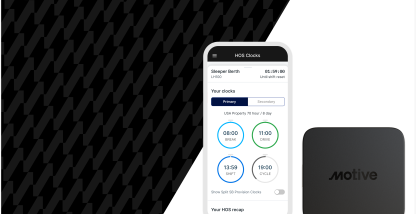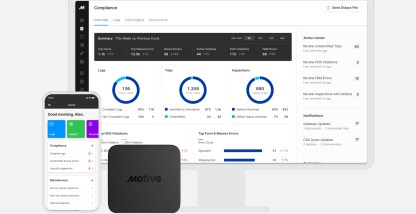There are a lot of good things to be said about the ELD mandate. Apart from saving millions of dollars by reducing paperwork and eliminating administrative tasks, the ELD mandate is also expected to save hundreds of lives. But there are also a lot of ELD mandate questions circulating.
The FMCSA estimates that the ELD mandate will save 26 lives and prevent 562 injuries every year. Additionally, with the ELD mandate, the trucking industry will be able to save approximately $1 billion every year.
The benefits are numerous.
Despite all the benefits of the ELD mandate, there is still some confusion among commercial truck drivers. Because of some misinformation and a few myths regarding the final ELD rule, some drivers are not exactly sure how the ELD mandate is going to help them.
This confusion leads to some commonly asked questions that commercial drivers ask about the FMCSA’s ELD mandate. In this blog post, we cover some of the frequently asked ELD mandate questions.
The top 10 ELD mandate questions and answers.
1. What is an electronic logging device?
According to the Moving Ahead for Progress in the 21st Century Act (MAP-21), an electronic logging device (ELD) is operationally defined as any device that:
- Has the capability to automatically and accurately record a driver’s duty status and Hours of Service (HOS), and
- Has met the established requirements by the Secretary of Transportation through regulation.
It means that the ELD has to be a hardware device. An elog mobile application won’t be enough after the ELD mandate deadline.
2. What are the general requirements of an ELD?
Based on the prescribed regulations under MAP-21, ELDs needs to:
- Be able to record a commercial driver’s HOS accurately
- Be able to record the whereabouts of a commercial motor vehicle (CMV)
- Be tamper resistant
- Be synchronized to the vehicle engine’s operation or have the capability of recognizing whenever the vehicle is being operated.
ELDs must also allow law enforcement personnel to have access to the data contained in the device during roadside inspections.
3. How do I know if my ELD is tamper resistant?
You’ll know that your ELD is “tamper resistant” if it is resistant to individuals causing it:
- to record the incorrect date, location, and time for any change to the on-duty driving status of CMV operators — per guidelines under Code of Federal Regulations, Title 49, Part 395 (49 CFR 395); or,
- to alter the records created by the device.
The best way is to only rely on FMCSA-registered ELDs. If an ELD is registered with the FMCSA, it implies that the particular device is perfectly in line with the regulations and will guarantee compliance.
4. Do ELDs really improve safety?
Yes.
The whole purpose of introducing ELDs is to improve road safety and save as many lives as possible. In fact, it is the DOT’s aim to eliminate road deaths by 2046.
A while ago FMCSA released a report. As per that report, 11.7% fewer accidents were recorded for vehicles with ELDs. Also, drivers who use ELDs in their vehicles had 53% fewer HOS violations.
5. What is the ELD Mandate?
The ELD Mandate is a final rule published by the FMCSA on December 16, 2015. It mandates the use of ELDs for recording Hours of Service.
The ELD rule is applied to most drivers and motor carriers who are required to prepare and retain a paper version of the RODS to comply with the HOS regulations under 49 CFR 395. According to the ELD mandate, eligible commercial drivers and motor carriers are required to implement ELDs by December 18, 2017 — which is the ELD mandate deadline.
Those who are currently using Automatic Onboard Recorders (AOBRDs) have two additional years for implementing ELDs. For AOBRD users, the final ELD implementation deadline is December 16, 2019.
6. Are all drivers required to use ELDs?
No. Some are exempt from using ELDs. The four exemptions are:
- Drivers who perform driveaway-towaway operations, wherein the vehicle that is being driven is the commodity that is being delivered; and,
- Drivers of vehicles that were manufactured before the model year 2000.
- Drivers who do not have to maintain Record of Duty Status (RODS).
- Drivers who maintain RODS for less than 9 days in a 30-day period.
7. How is the model year of my vehicle determined?
As specified by FMCSA’s final rule, the model year of CMVs is identified and determined by its vehicle identification number (VIN) located on the chassis of the CMV. Therefore, even if your truck has a glider engine installed that was manufactured before the year 2000, if your CMV’s VIN indicates the model year of 2000 or newer, then it requires an ELD.
8. Will the ELD shut my truck down if I exceed my Hours of Service limits?
No, it won’t.
The primary function of ELDs is to measure and track vehicle movements. ELDs are not capable of shutting down vehicles.
Drivers always have complete control over their vehicles. So even when they exceed their HOS limits, ELDs won’t be able to shut down their vehicles.
9. How exactly can ELDs help me as a truck driver?
Some drivers don’t believe that ELDs can help them. However, ELDs are going to make their lives a lot easier.
Electronic logging devices (ELDs) will take off a lot of burden by automating tasks, reducing violations, and minimizing distractions, which, in turn, helps drivers focus on driving and earning more money.
For instance, ELDs will eliminate Form & Manner violations. The problem of outdated and falsified logs will also be solved with the help of ELDs. Also, ELDs alert drivers for upcoming HOS violations. With audible alerts and notifications, drivers will be able to stop their vehicles in time and park at a safe spot.
Additionally, most ELDs are packed with amazing features, such as GPS tracking, messaging with fleet managers, driver scorecards, idle-time tracking, etc. Drivers can use these features to not only make communication with fleet managers and dispatchers easy and distraction-free, but they can also identify their driving behaviors and improve.
10. How can ELDs increase profits?
As mentioned earlier, ELDs help everyone earn more by reducing administrative burdens, automating tasks, and eliminating processes that hog valuable resources.
ELDs with features such as GPS tracking allow fleet managers and commercial drivers to plan better routes and get to their destinations quicker than ever. With features such as idle-time tracking, ELDs can identify and significantly reduce fuel wastage. According to an estimate, for a truck that consumes $70,000 of fuel per year, approximately $5,600 is spent on idling. ELDs can help you identify it and save a lot of money.
In a fleet with hundreds of trucks, it becomes a significant amount of money.
ELDs can also detect fault codes in real time. Drivers and managers are notified immediately in case of vehicle maintenance issues. ELDs also help you identify recurring issues in time with historical fault code reports.
In the case of accidents, ELDs can help drivers that are not at fault. Drivers can present the data gathered by ELDs as evidence that he wasn’t the culprit. Courts will evaluate ELD data, such as hard braking, acceleration, and hard cornering, and, if drivers aren’t at fault, they can save themselves from hefty fines and liabilities.
What’s next?
If you still have additional ELD mandate questions, call our support team at 855-434-3564 or email us at support@gomotive.com.
Also, if you want to experience firsthand how you can benefit from using Motive ELDs, request a free demo of our ELD solution now. One of our product specialists will get in touch with you.









